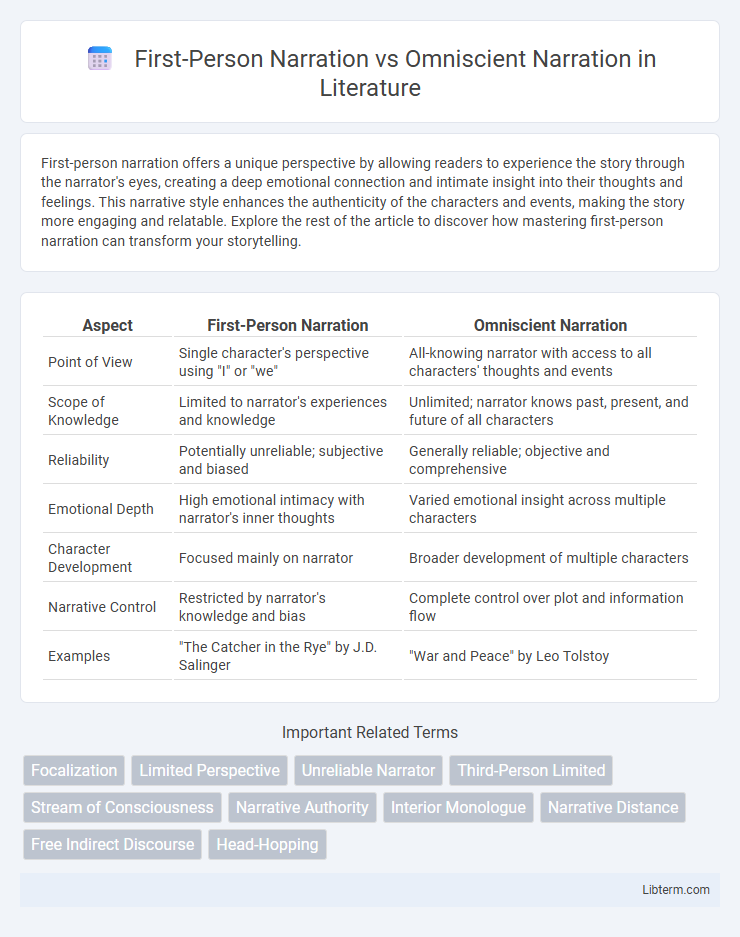First-person narration offers a unique perspective by allowing readers to experience the story through the narrator's eyes, creating a deep emotional connection and intimate insight into their thoughts and feelings. This narrative style enhances the authenticity of the characters and events, making the story more engaging and relatable. Explore the rest of the article to discover how mastering first-person narration can transform your storytelling.
Table of Comparison
| Aspect | First-Person Narration | Omniscient Narration |
|---|---|---|
| Point of View | Single character's perspective using "I" or "we" | All-knowing narrator with access to all characters' thoughts and events |
| Scope of Knowledge | Limited to narrator's experiences and knowledge | Unlimited; narrator knows past, present, and future of all characters |
| Reliability | Potentially unreliable; subjective and biased | Generally reliable; objective and comprehensive |
| Emotional Depth | High emotional intimacy with narrator's inner thoughts | Varied emotional insight across multiple characters |
| Character Development | Focused mainly on narrator | Broader development of multiple characters |
| Narrative Control | Restricted by narrator's knowledge and bias | Complete control over plot and information flow |
| Examples | "The Catcher in the Rye" by J.D. Salinger | "War and Peace" by Leo Tolstoy |
Introduction to Narrative Perspectives
First-person narration offers an intimate viewpoint by presenting the story through a character's direct experiences and thoughts, enhancing emotional connection and subjective insight. Omniscient narration provides an all-knowing perspective, revealing multiple characters' internal states and broader contextual information to create a comprehensive understanding of the story world. These contrasting narrative perspectives shape how readers perceive characters, plot development, and thematic depth within a literary work.
Defining First-Person Narration
First-person narration is a storytelling perspective where the narrator is an active character within the story, using pronouns like "I" and "we" to provide a personal account of events. This narrative style offers direct insight into the narrator's thoughts, feelings, and experiences, creating an intimate connection between the reader and the protagonist. Unlike omniscient narration, first-person narration limits the scope of knowledge to the subjective viewpoint of the narrator, which can introduce bias and unreliable narration.
Understanding Omniscient Narration
Omniscient narration provides a comprehensive perspective by revealing the thoughts, feelings, and motivations of multiple characters, unlike first-person narration which is limited to a single character's viewpoint. This narrative technique allows readers to grasp the broader context of the story, exploring various plotlines simultaneously. Key authors known for mastering omniscient narration include Leo Tolstoy and George Eliot, who utilize this style to create rich, multi-dimensional narratives.
Key Differences Between First-Person and Omniscient Narration
First-person narration provides a limited perspective, revealing the inner thoughts, feelings, and experiences of a single character, creating a personal and subjective viewpoint. Omniscient narration offers an all-knowing vantage point, allowing insight into multiple characters' thoughts, motivations, and the broader context of the story world. The key difference lies in scope and depth: first-person restricts the narrative to one character's consciousness, while omniscient narration delivers a comprehensive, objective understanding of the entire narrative landscape.
Advantages of First-Person Narration
First-person narration offers a deeply immersive perspective, allowing readers to connect intimately with the narrator's thoughts, emotions, and experiences. This point of view enhances character development through authentic inner dialogue and subjective insights, creating a strong emotional bond between the reader and protagonist. The immediacy and personal bias inherent in first-person narration also contribute to a nuanced, layered storytelling experience that can heighten tension and reliability complexities.
Benefits of Omniscient Narration
Omniscient narration offers a comprehensive perspective by providing insight into multiple characters' thoughts, emotions, and motivations, enhancing narrative depth and complexity. This narrative style allows seamless shifts in time and space, enriching world-building and plot development. Writers benefit from omniscient narration through the ability to create a more immersive and multifaceted storytelling experience.
Common Uses in Literature
First-person narration is commonly used in literature to provide an intimate and subjective perspective, allowing readers to closely connect with the protagonist's thoughts and emotions in novels like "The Catcher in the Rye" by J.D. Salinger. Omniscient narration offers a god-like viewpoint that reveals multiple characters' inner experiences and broader contexts, as seen in works like Leo Tolstoy's "War and Peace." These narrative styles serve different purposes: first-person narration excels in building personal voice and immediacy, while omniscient narration facilitates complex plot development and a comprehensive understanding of the story world.
Impact on Reader Engagement and Intimacy
First-person narration fosters deep reader intimacy by offering direct access to the narrator's thoughts and emotions, enhancing emotional connection and empathy. Omniscient narration provides a broader perspective, enabling readers to understand multiple characters' motivations and plot intricacies, which can increase engagement through complex storytelling. The choice between these perspectives influences how readers experience the narrative, balancing personal immersion with comprehensive insight.
Choosing the Right Narration Style for Your Story
Choosing the right narration style for your story depends on the level of intimacy and perspective you want to convey. First-person narration offers a deep, subjective view of the protagonist's thoughts and emotions, creating a strong personal connection with readers. Omniscient narration provides a broader, all-knowing perspective that can reveal the inner lives of multiple characters and offer a more comprehensive understanding of the plot.
Conclusion: Finding Your Narrative Voice
Choosing between first-person narration and omniscient narration depends on the desired intimacy and scope of your story. First-person narration offers deep emotional connection through a single character's perspective, while omniscient narration provides a comprehensive view of multiple characters and events. Identifying your narrative voice requires understanding which point of view best conveys your story's themes and engages your audience effectively.
First-Person Narration Infographic

 libterm.com
libterm.com